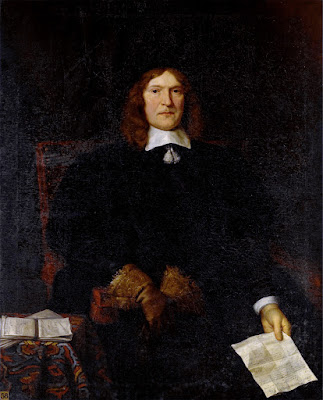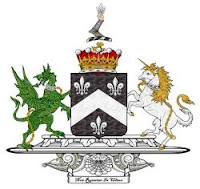This noble family stands in the first rank of ancient Cambrian houses, and is almost without parallel for prolonged undisturbed possession of the original seat and estate.
The manor and mansion of Trawscoed came into the Vaughan family by the marriage of Adda Fychan with Tudo, daughter and heiress of Ifan Goch of Trawscoed, ‘Evan the Red', in 1200, and have never since been alienated, nor, it is believed, ceased to be occupied by the possessors.
The pedigree is deduced by well ascertained steps of descent from Collwyn ap Tangno, Lord of Eifionydd, founder of the very noble tribe of North Wales.
Of this ancient family, which has flourished at Trawscoed (Crosswood), Cardiganshire, for more than fifteen generations, in a direct line, was
SIR JOHN VAUGHAN (1603-74), Knight, of Trawscoed, Llanafan, Cardiganshire, and Inner Court, London, an eminent lawyer, constituted Lord Chief Justice of the Common Pleas, 1668.
The Trawscoed Estate has been in the continuous ownership of the Vaughans, Earls of Lisburne, since the 14th century.
Trawscoed became known by its English name, Crosswood, in 1800.
In the 1870s, the addition of a billiards-room with an extra floor above was planned, but by 1891 further renovation was required, and the massive west wing dates from that year, designed by T W Aldwinckle and erected at a cost of £13,973 (about £1.8 million in 2019).
 |
| Sir John Vaughan |
SIR JOHN VAUGHAN (1603-74), Knight, of Trawscoed, Llanafan, Cardiganshire, and Inner Court, London, an eminent lawyer, constituted Lord Chief Justice of the Common Pleas, 1668.
He married Jane, daughter of John Stedman, and was father of
EDWARD VAUGHAN (c1635-84), of Trawscoed, and Great Russell Street, London, MP for Cardiganshire, 1669-81, and for a short time one of the Lords of the Admiralty, who wedded, in 1665, Letitia, daughter of Sir William Hooker, grocer, of Crown Court, Gracechurch Street, London.
Mr Vaughan was succeeded by his eldest son,
JOHN VAUGHAN (1667-1721), of Trawscoed, MP for Cardiganshire, 1694-8, who espoused, in 1692, the Lady Malet Wilmot, third daughter of John, 2nd Earl of Rochester, and had issue,
JOHN, his successor;WILMOT, succeeded his brother;Henry;Anne; Elizabeth; Letitia.
Mr Vaughan was elevated to the Irish peerage, in 1695, in the dignities of Baron Fethard, of Fethard, County Tipperary, and Viscount Lisburne, of County Antrim.
His lordship was succeeded by his eldest son,
JOHN, 2nd Viscount (1695-1741);
Who, claiming his seat in the Irish House of Lords, was refused admission, in consequence of the deceased 1st Viscount having omitted the enrolment of his patent according to the act of parliament; whereupon he presented a petition to the House, stating the reasons of the omission, and praying that his case might be taken into consideration; but Parliament being soon afterwards prorogued, no proceedings ensued.
His lordship married twice, and had one daughter; though having no male issue, the honour devolved upon his brother,
WILMOT, 3rd Viscount; who espoused, in 1727, Elizabeth, eldest daughter of Thomas Watson, and had issue,
WILMOT, his successor;John;Malet;Elizabeth.
His lordship was succeeded by his eldest son,
WILMOT, 4th Viscount (1730-1800), who married firstly, in 1754, Elizabeth Gascoigne, daughter of Joseph Gascoigne Nightingale, of Mamhead, Devon, and eventually heir to her brother, Washington Nightingale, by whom he had an only son,
WILMOT, his successor.
He wedded secondly, in 1763, Dorothy, daughter of John Shafto, of Whitworth, County Durham, and had further issue,
JOHN, succeeded his brother as 3rd Earl;Dorothy Elizabeth; Mallet; Theodosia Charlotte.
The 4th Viscount, politician and parliamentarian in the House of Commons, was elevated to an earldom in the Irish peerage, in 1776, in the dignity of EARL OF LISBURNE.
Irish peers were not entitled to sit in the House of Lords at Westminster; they were, however, entitled to sit as MPs in the House of Commons.
His lordship was succeeded by his elder son,
WILMOT, 2nd Earl (1755-1820), who died unmarried, when the honours devolved upon his half-brother,
JOHN, 3rd Earl (1769-1831).
- John Vaughan, 3rd Earl (1769–1831)
- Ernest Augustus Mallet Vaughan, 4th Earl (1800–1873)
- Ernest Augustus Malet Vaughan, 5th Earl
- George Henry Arthur Vaughan, 6th Earl (1862–1899)
- Ernest Edmund Henry Malet Vaughan, 7th Earl (1892–1963)
- John David Malet Vaughan, 8th Earl (1918–2014)
- David John Francis Malet Vaughan, 9th Earl (born 1945)
The heir presumptive is the current holder's brother, the Hon Michael John Wilmot Vaughan (b 1948).
The heir presumptive's heir apparent is his son Edward Wilmot Malet Vaughan (b 1998).
CROSSWOOD, or Trawscoed, is a large masion house, thought to be the principal country house in Cardiganshire.The house retains many significant architectural features from the 17th, 18th, and 19th centuries, of particularly the library which dates from about 1840.
In 1947 the house was sold to the Ministry of Works, but was re-acquired by the Vaughan family in 1996; and the Victorian wing was subsequently converted into apartments.
Trawscoed House suffered damage during the Civil Wars, though it was largely rebuilt by Sir John Vaughan in the 1660s.
Sir John Vaughan’s grandson, John, was created Viscount Lisburne in 1695.
The 2nd Viscount, however, incurred substantial debts and the fortunes of the estate suffered under his tenure.
The 1st Earl was a great collector of books, and his son constructed the notable library at Trawscoed, although the ornate decorations of marbled Corinthian columns and richly painted ceilings are probably Victorian in date.
In 1795 the 3rd Earl extensively remodelled the eastern wing in Regency style, incorporating 17th century portions of the building, now resurfaced, including a new entrance through a portico, with columns and balusters topped with the family coat-of-arms.
Trawscoed became known by its English name, Crosswood, in 1800.
Improvements to the house continued throughout the 19th century.
 |
| Trawscoed (Image: the DiCamillo Companion) |
In the 1870s, the addition of a billiards-room with an extra floor above was planned, but by 1891 further renovation was required, and the massive west wing dates from that year, designed by T W Aldwinckle and erected at a cost of £13,973 (about £1.8 million in 2019).
In 1947, the mansion was sold by the 7th Earl, and became the Welsh headquarters of the National Agricultural Assistance Service.
In 1996, the Vaughan family re-purchased the mansion, having retained the right of first refusal, and in the same year the Victorian wing was converted into five apartments.
It has since passed to other private owners.
In the latter part of the 20th century, despite partial renovations and conservation efforts from multiple owners, the structure suffered substantially from dry rot and deteriorated markedly.
First published in February, 2021. Lisburne arms courtesy of European Heraldry.


No comments:
Post a Comment